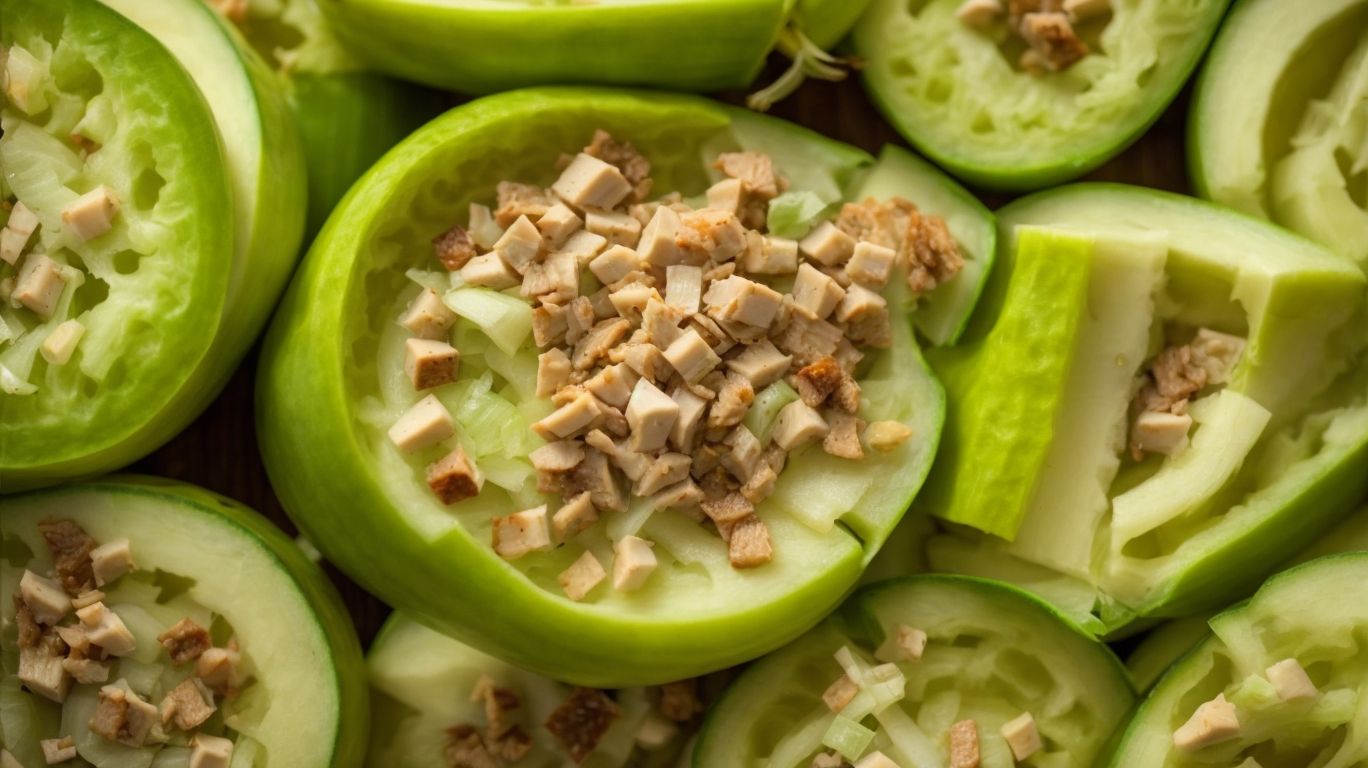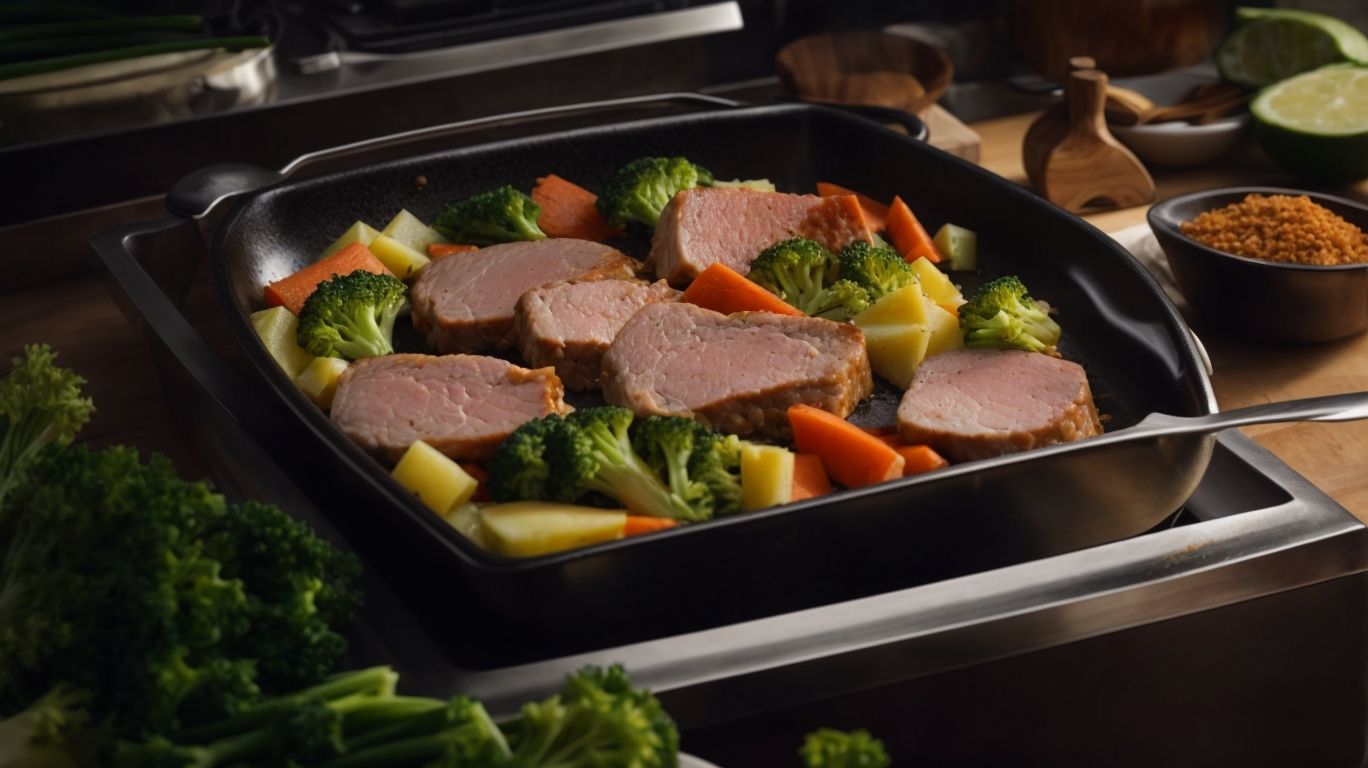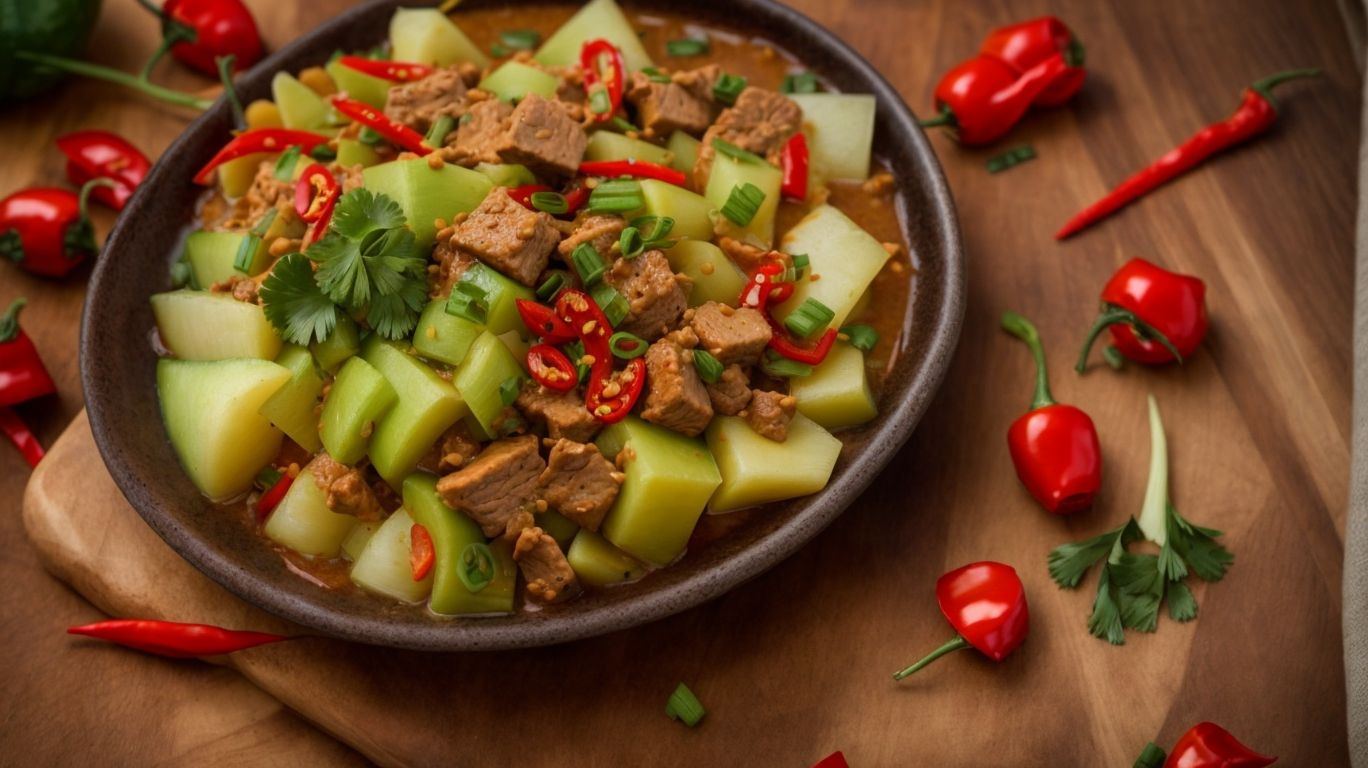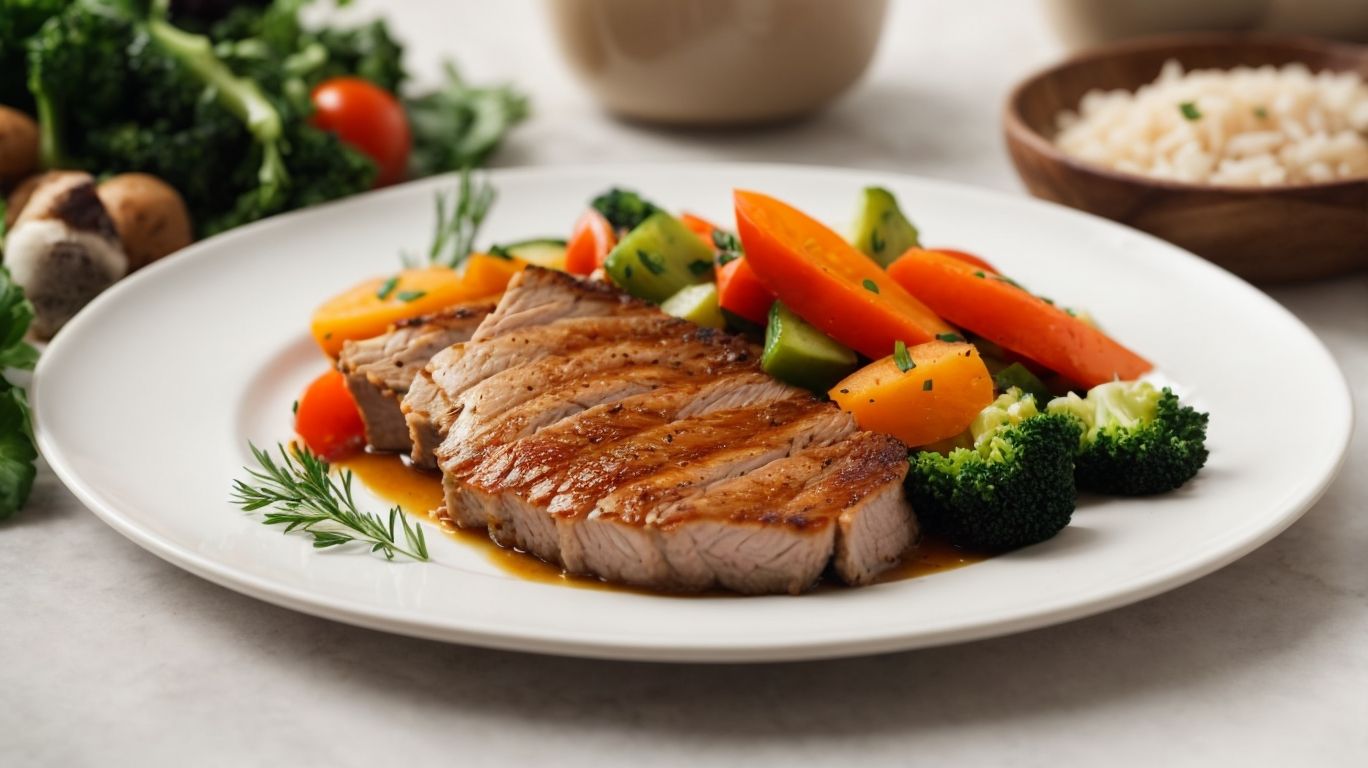How to Cook Upo With Pork?
Are you looking to add a new, delicious dish to your cooking repertoire? Look no further than Upo with Pork!
We discuss the wonders of Upo, also known as bottle gourd or calabash, its health benefits, and how to select and prepare it for cooking.
Explore the ingredients you need and step-by-step instructions on how to cook Upo with Pork to perfection.
Stay tuned for some tips and tricks that will elevate your dish to the next level!
Key Takeaways:
About Chris Poormet and Poormet.com
Chris Poormet, the owner of Poormet.com, is a renowned culinary blogger known for sharing award-winning recipes and culinary tips.
With a professional background as a former chef, Chris brings a unique blend of expertise to his food photography, capturing the essence of each dish in a visually engaging way. His journey from the culinary world to the digital realm has allowed him to showcase his creativity both in the flavors he creates and the images he captures. Through his blog, Chris not only provides delicious recipes but also offers insights and techniques gathered from years of experience in the kitchen.
His dedication to quality and his eye for detail have garnered him a dedicated following, with many eagerly awaiting each new post on Poormet.com. Whether you’re a seasoned home cook or a beginner in the kitchen, Chris’s blog is a valuable resource for anyone looking to elevate their culinary skills and expand their recipe repertoire. As an accomplished food photographer, Chris Poormet continues to inspire and delight his audience with his mouth-watering creations and captivating visuals.
What is Upo?
Upo, also known as bottle gourd, is a popular vegetable in Filipino cuisine, known for its versatile uses in various dishes.
The Upo is a staple in Filipino households due to its mild flavor and ability to absorb the flavors of other ingredients it is cooked with. It has a high water content, making it a great addition to soups, stews, and stir-fries, providing a refreshing and hydrating element to the dish. Versatile in nature, Upo can be stuffed, sautéed, curried, or used as a natural container for other fillings, enhancing the overall presentation of the meal. Its texture adds a delightful contrast in mixed vegetable dishes and complements meat dishes exceptionally well.
What Are the Different Names of Upo?
Upo, also referred to as bottle gourd, calabash, long melon, or white-flowered gourd, is known by various names across different cultures.
In Asia, particularly in the Philippines, it is commonly known as ‘upo’ and plays a significant role in local cuisine. In India, it is called ‘lauki’ or ‘sorakaya,’ frequently used in curries and stews. In Africa, it is referred to as ‘calabash’ and holds cultural symbolism in some regions. The versatility of this vegetable allows it to be used in soups, stir-fries, and even desserts, enhancing both the taste and nutritional value of dishes. The elongated shape and mild flavor of Upo make it a popular choice in various traditional recipes around the world.
What Are the Health Benefits of Upo?

Credits: Poormet.Com – Richard Torres
Upo offers a range of health benefits, including being nutrient-rich, supporting digestion, boosting the immune system, and promoting healthy skin and hair.
Its high nutritional value makes it an excellent addition to a balanced diet, providing essential vitamins and minerals like vitamin C, potassium, and fiber. These nutrients not only help in maintaining overall health but also contribute to strong immunity. The fiber content in Upo aids in smooth digestion, preventing digestive issues and promoting gut health. Its antioxidant properties play a significant role in improving skin and hair health, offering a natural glow and strength to hair strands.
High in Nutrients and Low in Calories
Upo is a nutrient-dense vegetable that is low in calories, making it an excellent choice for maintaining a healthy diet.
Its high water content not only contributes to hydration but also aids in weight management, as it helps create a feeling of fullness without adding significant calories. Upo is a rich source of essential vitamins like vitamin C, A, and K, crucial for supporting immune function and maintaining healthy skin and eyes.
Upo is packed with dietary fiber, promoting digestive health and aiding in proper digestion. Its antioxidants properties help combat oxidative stress and inflammation in the body, reducing the risk of chronic diseases.
Helps with Digestion
Consuming Upo can aid in digestion due to its fiber content and digestive properties, supporting overall gut health.
Upo, also known as bottle gourd, is a versatile vegetable commonly used in various cuisines. It is rich in soluble and insoluble fiber, which plays a crucial role in maintaining a healthy digestive system. The fiber in Upo helps regulate bowel movements, prevent constipation, and promote the growth of beneficial bacteria in the gut.
Upo contains antioxidants and anti-inflammatory compounds that can reduce inflammation in the digestive tract, easing digestive discomfort. These properties make Upo a great choice for individuals looking to improve their digestive health naturally.
Boosts Immune System
Upo is known to boost the immune system, thanks to its rich array of vitamins, minerals, and antioxidants that support overall immunity.
One of the key vitamins present in upo is Vitamin C, which plays a crucial role in enhancing immune function by stimulating the production of white blood cells that help fight off infections.
Additionally, minerals like potassium and manganese found in upo contribute to the proper functioning of immune cells, aiding in the body’s defense mechanism.
The antioxidants in upo, such as beta-carotene and lutein, help combat oxidative stress and inflammation, thereby strengthening the immune system’s resilience.
Promotes Healthy Skin and Hair
The nutrients found in Upo promote healthy skin and hair, contributing to a radiant complexion and strong, lustrous hair.
Upo is rich in essential vitamins and minerals such as vitamin C, which helps with collagen production for skin elasticity and hair growth. Its high water content keeps the skin hydrated and supple, preventing dryness and dullness. The presence of antioxidants in Upo shields the skin from environmental damage, reducing signs of aging and maintaining a youthful appearance.
How to Select and Prepare Upo for Cooking?
Selecting and preparing Upo for cooking requires attention to detail to ensure optimal flavor and texture in the final dish.
When choosing Upo, look for ones that are firm, heavy for their size, and have a consistent green color without any blemishes or soft spots. To prepare Upo, start by washing it thoroughly under running water to remove any dirt or debris. Next, use a sharp knife to carefully peel off the skin, ensuring to remove all the tough outer layer.
Cut the Upo into desired shapes, such as rounds, cubes, or strips, depending on the recipe you plan to use. To enhance its flavor, you can marinate Upo with your favorite seasonings or cook it with aromatic herbs and spices.
When cooking Upo, consider methods like stir-frying, steaming, or adding it to soups and stews. Be mindful not to overcook Upo, as it can become mushy and lose its delicate texture. With these steps, you can elevate the taste of Upo and create delicious dishes that showcase this versatile vegetable.
Choosing a Fresh Upo
When selecting Upo for cooking, look for firmness, vibrant color, and absence of blemishes to ensure freshness and quality.
For firmness, gently press the Upo to check if it feels solid and not soft or mushy. A vibrant color indicates that the vegetable is ripe and fresh. Avoid any Upo with blemishes or bruises on the surface, as they might indicate spoilage. Make sure the surface of the Upo is smooth and free from any wrinkling or discoloration. These criteria are essential to ensure that you are cooking with the best quality and freshest Upo available.
Preparing Upo for Cooking
Preparing Upo for cooking involves washing, peeling, and slicing the vegetable according to the recipe requirements, ensuring uniformity in size and texture.
Start by thoroughly rinsing the Upo under cold running water to remove any dirt or residues. Next, using a sharp knife, carefully peel the skin off the vegetable, making sure to remove any tough or uneven parts.
Regarding slicing the Upo, aim for consistent thickness to promote even cooking. Whether you prefer rounds, cubes, or strips, maintaining uniformity is key for ideal results.
By following these steps, you’ll set the foundation for a delicious Upo dish that’s not only visually appealing but also perfectly cooked.”
What Ingredients Do You Need for Upo with Pork?
To prepare Upo with Pork, you will need fresh Upo, succulent pork, aromatic garlic and onion, along with a blend of seasonings and spices for flavor enhancement.
Along with these key ingredients, you may also require ingredients like soy sauce, fish sauce, vinegar, and a touch of sugar for balancing the flavors. The Upo should be cut into uniform pieces, while the pork can be choice cuts like pork belly or shoulder for a rich and tender result. The garlic and onion will need to be finely minced to release their full aroma and flavor during cooking. Don’t forget to have some vegetable oil on hand for sautéing and cooking everything to perfection.
Upo
Upo, the star ingredient of this dish, lends its mild flavor and tender texture to create a delectable culinary experience when combined with pork.
Also known as bottle gourd or calabash, Upo belongs to the gourd family and is prized for its subtle taste that easily absorbs the flavors it is cooked with. Its soft, almost creamy flesh pairs harmoniously with the savory richness of pork, resulting in a dish that is both comforting and satisfying. When cooked, Upo retains a slight crunch, adding a delightful textural contrast to the tender pieces of pork. Its culinary versatility makes it an excellent canvas for absorbing the aromatic spices and seasonings used in this recipe, enhancing the overall depth of flavor.
Pork
The addition of succulent pork to the Upo dish introduces rich flavors and hearty textures, enhancing the overall taste profile of the meal.
Regarding incorporating pork in this dish, it plays a crucial role in providing a depth of flavor due to its natural fat content and unique umami notes. Pork adds a juicy tenderness that complements the softness of the Upo squash, creating a harmonious blend of textures.
Exploring different cooking techniques opens up a world of possibilities – from braising the pork in a savory broth to roasting it with aromatic herbs and spices, each method imparts a distinct character to the dish.
Garlic and Onion
The aromatic duo of garlic and onion adds depth and complexity to the Upo and Pork dish, infusing it with savory flavors and enticing aromas.
Garlic, with its pungent and slightly spicy profile, amplifies the dish’s overall taste, while onions, known for their sweet undertones, complement the flavors perfectly.
When cooking with garlic, mincing or crushing it releases its essential oils and enhances its flavor, providing a robust base for the dish. On the other hand, sautéing onions until they are translucent brings out their natural sweetness, balancing the savory elements.
By incorporating these aromatics strategically throughout the cooking process, you can build layers of flavor and create a delicious, well-rounded dish that tantalizes the taste buds.
Seasonings and Spices
A blend of seasonings and spices enriches the Upo and Pork dish with a harmonious mix of flavors, creating a delicious and aromatic culinary masterpiece.
One key spice that adds depth to this dish is cumin, known for its warm and earthy notes. Cumin pairs beautifully with the sweet-savory flavors of pork, enhancing its natural richness. The subtle heat of paprika can provide a pleasant kick without overpowering the dish. To balance these flavors, consider adding a hint of coriander, which imparts a fresh and citrusy undertone.
Integrating these spices can be as simple as sprinkling them over the ingredients before cooking, or creating a spice rub to infuse the flavors deeply into the meat and vegetables. Experimenting with different combinations of seasonings allows for endless possibilities to elevate your culinary creations.
How to Cook Upo with Pork?

Credits: Poormet.Com – Zachary Clark
Cooking Upo with Pork involves a delightful combination of sautéing the pork, adding the Upo and seasonings, and simmering the ingredients to tender perfection.
Begin the process by heating a pan over medium heat and sautéing thinly sliced pork until it reaches a golden brown color, infusing the dish with savory flavors. Next, incorporate the sliced Upo, allowing it to absorb the juices from the pork and spices for a harmony of tastes. To enhance the dish even further, sprinkle in a dash of salt, pepper, and your favorite seasonings, such as garlic powder or paprika, for an added depth of flavor.
Sauté the Pork
Begin the cooking process by sautéing the pork in a hot pan until it is lightly browned and infused with savory flavors, setting the foundation for a delicious Upo dish.
Sautéing the pork is a crucial step that not only enhances the flavors but also contributes to the overall texture of the dish. The key to achieving that perfect golden-brown color lies in ensuring the pan is adequately preheated before adding the pork. This initial searing process helps to seal in the juices, creating a juicy and tender final product.
As the pork sizzles in the pan, take the time to occasionally stir and flip the pieces to ensure even browning on all sides. This step is essential for developing complex flavors and creating a mouthwatering aroma that will entice your senses.
Add the Upo and Seasonings
Incorporate the sliced Upo and a medley of seasonings into the pan, allowing the flavors to meld together and infuse the dish with a delightful combination of tastes and aromas.
As the Upo begins to cook, consider adding a pinch of salt to enhance its natural flavors. The blending of spices such as garlic powder, cumin, and paprika can create a depth of taste that complements the mildness of the Upo.
Experimenting with different herbs like fresh cilantro or dried basil can elevate the dish to a whole new level. You can also consider incorporating a splash of soy sauce or a dash of balsamic vinegar for a touch of umami. These additions not only add complexity but also help balance out the flavors.
Simmer until Tender
Allow the dish to simmer gently until the Upo and pork are tender, ensuring that the flavors are fully absorbed, and the ingredients reach a delightful state of readiness for serving.
Simmering is a crucial step in the cooking process, as it allows the flavors to meld together, creating a harmonious taste profile. When the dish simmers, the liquid reduces, intensifying the flavor concentration and richness. The gentle heat softens tough cuts of meat, like pork, making them succulent and easy to chew.
Texture is another aspect to consider during simmering. The gradual cooking process breaks down the fibers in the Upo, resulting in a silky, smooth texture that enhances the overall dish. Visual cues, such as the meat falling off the bone or the Upo becoming translucent, indicate that the ingredients have reached optimal tenderness and are ready to be enjoyed.
Tips and Tricks for Cooking Upo with Pork

Credits: Poormet.Com – Billy Lee
Enhance your culinary prowess with expert tips and tricks for cooking Upo with Pork, ensuring a flavorful and satisfying meal every time.
When preparing Upo with Pork, start by selecting a fresh and firm Upo squash, also known as bottle gourd, to ensure optimal taste and texture. To save time, consider prepping your ingredients in advance, such as slicing the pork into thin strips and dicing the Upo into uniform pieces. Marinating the pork in a mixture of soy sauce, garlic, and pepper before cooking can enhance its flavor profile. Experiment with adding a touch of oyster sauce or vinegar for a delicious twist to the dish.
Frequently Asked Questions
1. How to Cook Upo With Pork?
Cooking Upo with pork is a simple and delicious dish that can be made in just a few easy steps. All you need is fresh Upo, a protein-rich pork cut, and some basic ingredients to create a flavorful and satisfying meal.
2. What is Upo and where can I find it?
Upo is a type of gourd commonly found in Asian markets or specialty grocery stores. It is a versatile vegetable that has a mild and slightly sweet flavor, making it the perfect pairing for pork in this dish.
3. Do I need to prepare the Upo before cooking?
Yes, it is important to peel and remove the seeds from the Upo before cooking. The skin can be tough and the seeds can have a bitter taste, so it’s best to remove them before adding the Upo to the dish.
4. Can I use any type of pork for this recipe?
Yes, you can use any cut of pork that you prefer. However, I recommend using pork belly or pork shoulder for the best flavor and tenderness when cooking with Upo.
5. How do I know when the Upo is cooked?
The Upo should be soft and slightly translucent when cooked. You can test it by poking it with a fork or tasting a small piece. It should be tender but not mushy.
6. Can I add other vegetables to this dish?
Yes, you can add other vegetables such as carrots, onions, and bell peppers for added flavor and nutrition. Just make sure to adjust the cooking time accordingly for the different vegetables.





